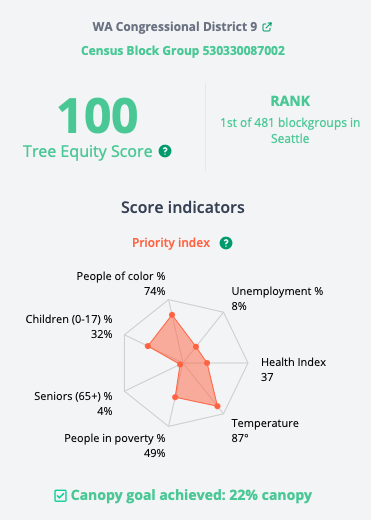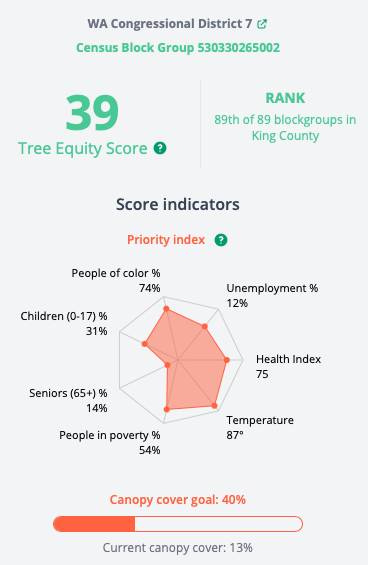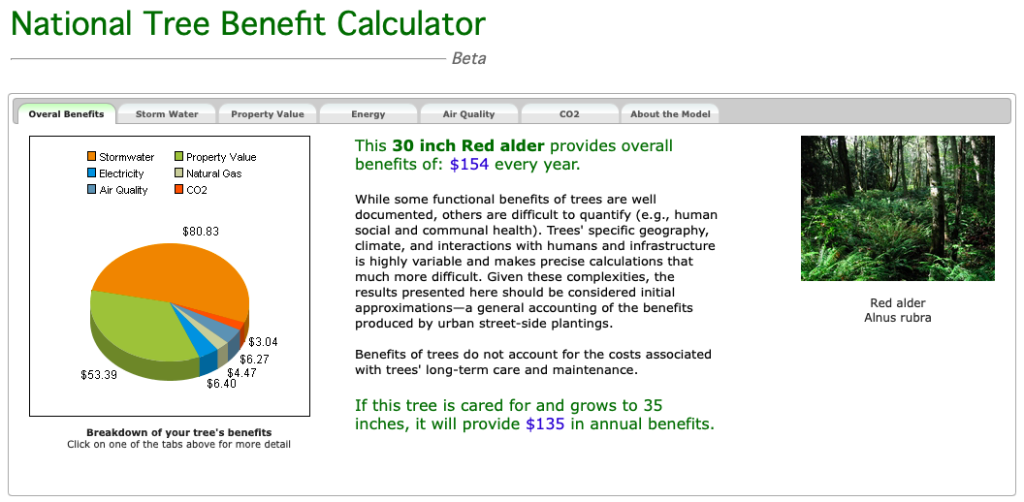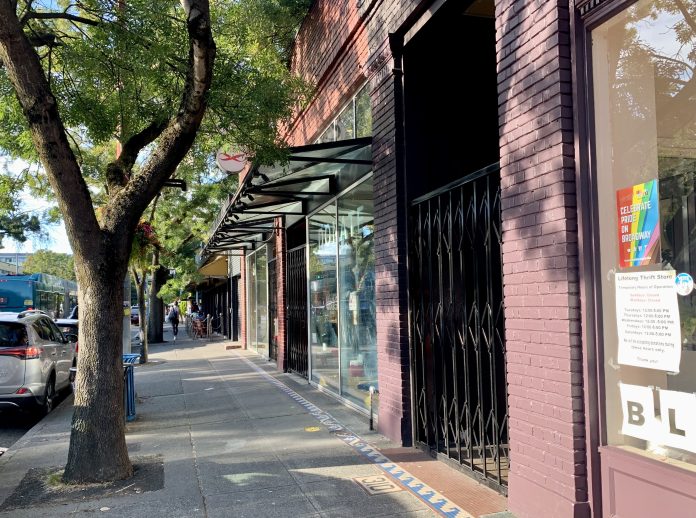
Recent data published by the nonprofit American Forests shows stark racial and economic inequity in tree canopy coverage. How did the Evergreen State compare to national trends?
There are certain visual clues that identify the socioeconomic status of an urban neighborhood, and in the United States one of these is the presence — or absence — of trees. Trees flourish in areas of American cities with high levels of investment, whether by affluent property owners, flourishing local tax revenues, or committed neighborhood advocates. However, in urban areas that suffer from longstanding disinvestment resulting from high concentrations of poverty and environmental pollution, trees, and the life-sustaining benefits they bring, tend to be rare. Because of the American legacy of environmental racism, exclusionary zoning, and disparities in intergenerational wealth, communities of color are disproportionately likely to lack tree canopy.
To examine gaps in tree canopy coverage in urban areas and understand how these gaps relate to factors like the race and socioeconomic status of inhabitants, nonprofit American Forests has created a new measurement tool called the Tree Equity Score (TES). Combining GIS (Geographic Information System) mapping data with information provided by the United States census on population density, demographics of residents, health trends, and urban heat indexes, the TES uses quantitive analysis to determine whether locations have enough trees to provide optimal health, economic and climate benefits to residents.
The initial launch of TES assessed data from 150,000 different American neighborhoods and 486 metropolitan areas. It found that in order to make up for discrepancies between levels of tree coverage in neighborhoods lacking resources and more affluent, often White majority neighborhoods, the United States must commit to planting 522 million trees in urban areas. On average, American neighborhoods home to a majority of people of color have 33% less tree canopy than majority White neighborhoods. Among lower-income communities, the disparity is evident as well: according to TES data, neighborhoods with 90% or more of their residents living in poverty have 41% less tree canopy than communities with only 10% or less of the population in poverty.
Growing concern over the dangers of urban heat island effect, a phenomenon exacerbated by the unfolding climate crisis, has led to awareness of the critical role trees play in preventing temperatures in urban areas from rising to dangerous levels during heat waves. The danger posed by such heat waves should not be underestimated. In the most recent heat wave that struck the Pacific Northwest, nearly 100 people died in Washington and Oregon because of related causes. In the Canadian province of British Columbia, the heatwave is thought to have contributed to over 700 sudden deaths in a single week.
Although, the need for tree equity in urban areas has never been more pronounced, data from the United States Forest Service indicates that loss of tree canopy continues to be a problem across the country. In fact, their data shows that approximately one tree is lost for every two trees planted or naturally regenerated in urban areas, hindering cities’ attempts to increase tree canopy coverage. If tree canopy continues to be lost at this rate in urban areas of America, it will decline by 8.3% by 2060. Tree loss is mostly attributed to natural disasters and the stress urban areas place on tree’s growth and disease resistance, but improper planting practices and the removal of trees for new development also contribute to the problem.
American Forests hopes the information it has compiled on tree equity can be used to benefit communities lacking tree coverage. “Our Tree Equity Score will help make us all accountable and create action at the local, state and national levels,” said Jad Daley, president and chief executive officer of American Forests in a press release. “It shows us exactly where the problems exist, where we need to concentrate investment to solve them, and where we need to bring people together — all different types of people and organizations.”
Washington State has a reputation as one of the most verdant places in North America. But does data on tree equity support this image or does it reveal discrepancies related to race and class in keeping with national trends?
How equitable is tree canopy distribution in the Evergreen State?
According to TES, slightly more than a third of Washington’s census block groups, the smallest unit of measurement used by the United States census, have a tree equity score below 75, the minimum target established by American Forests. And, yes, national patterns related to inequity are present: census block groups where a majority of residents identified as low-income or people of color scored well below the state’s average for tree canopy coverage.


To achieve a TES score of 75 or higher for all Washington census block groups, over 2.6 million trees would need to be planted, increasing statewide tree canopy by 2.9%. According to American Forests, such an increase would create measurable ecosystem benefits in the form of carbon sequestration and decreased rainwater runoff. It would also generate almost 20,000 jobs in urban forestry and other adjacent employment sectors.
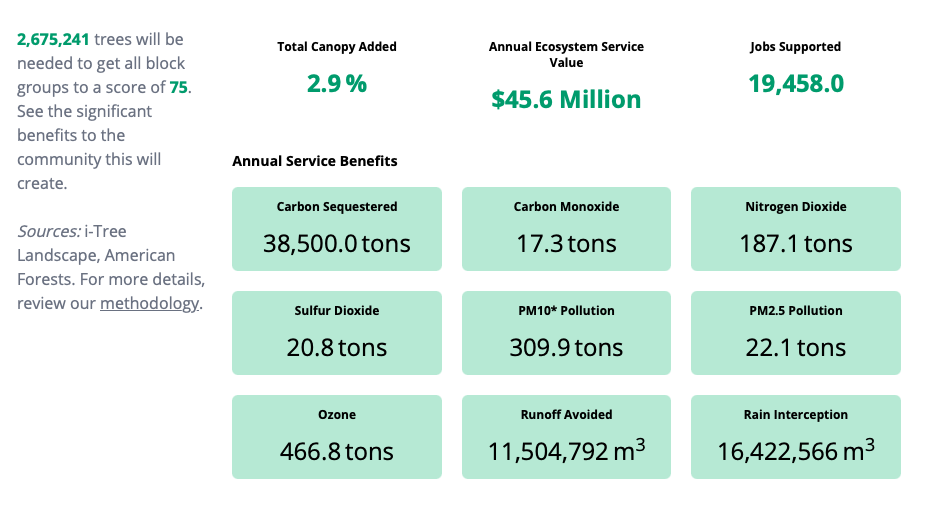
Home to an urban population of roughly 5.8 million people, Washington State’s cities differ in many ways, but as a whole, the largest cities scored respectably for tree equity, each earning above American Forests minimum target score of 75. Here’s a breakdown of the tree equity scores for the state’s eight largest cities:
- Seattle, 91
- Spokane, 77
- Tacoma, 77
- Vancouver, 76
- Bellevue, 80
- Kent, 78
- Everett, 78
- Renton, 83
To better understand how the TES works, and how it could be used in decision making by city officials, let’s take a closer look at Seattle.
Seattle: solid performance, with room for improvement
Achieving an overall tree equity score of 91, Seattle made a strong showing when compared to similarly sized cities nationally, performing slightly better than both Denver and San Francisco, which each earned the score of 88. Fellow Pacific Northwest metro, Portland, not only earned a lower score of 84, but was also highlighted by the report as one of the top 20 cities posed to benefit most from planting more trees in areas of need.
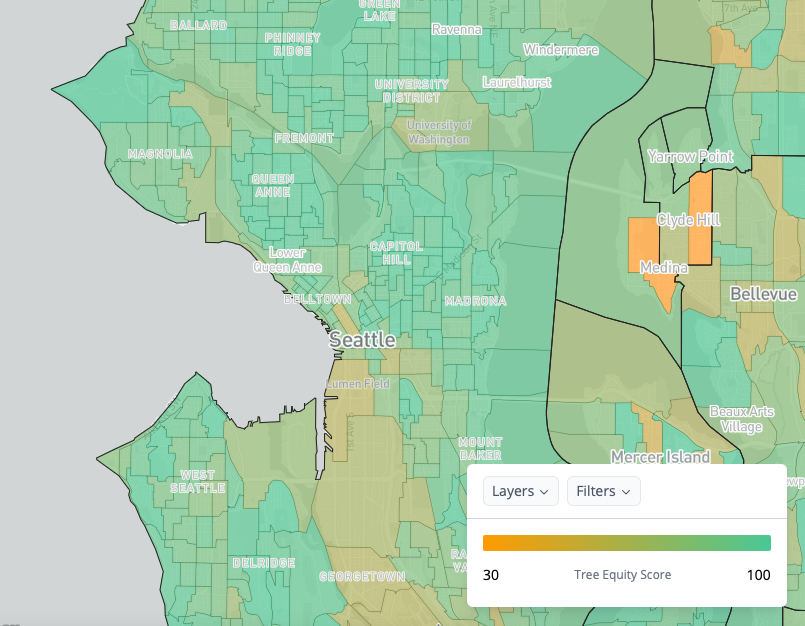
Examining one of the Seattle census block group areas that earned a perfect score of 100 offers insight into what tree equity looks like at work. Located in the Central District near the intersection of E Yesler Way and 23rd Avenue, the census block group profiled below includes large affordable housing sites run by nonprofits, yet it achieves its target tree canopy coverage of 22%.
As a whole, only 20 of Seattle’s 481 census block groups earned a score lower than 75, yet room for improvement in Seattle metro area exists, especially in South King County. One vivid example of an area lacking in tree equity is White Center, an unincorporated area just on the border of Southwest Seattle which has on and off been under discussion for annexation by Seattle or nearby Burien for years. Although all of the scores for the census block groups in White Center were below regional and state averages, one of them landed in at 39, the lowest score awarded for unincorporated King County.
Additionally, while Seattle is close to achieving target goals for tree equity, it would still need to plant a 39,660 trees to for all census block groups to earn the minimum score of 75 set by American Forests.
How can cities advance tree equity?
The path to planting 522 million trees in urban areas will be a long one, but reframing how trees are viewed in cities might accelerate the process. According to Ian Leahy, vice president of urban forestry at American Forests, considering trees to be core urban infrastructure and treating them as such could lead to a revaluation of trees in urban settings, provoking cities to invest more in planting and caring for them. Cities interested in quantifying the value of trees can refer to the National Tree Benefit Calculator (NTBC). According to data from the NTBC, a 30-inch alder tree planted in a multifamily residential zone in Seattle’s 98118 zip code, one of the most diverse zip codes in the country, would provide approximately $154 in benefits annually, primarily by filtering stormwater runoff.
In instances where public sector budgets run tight, a Seattle-based nonprofit, City Forest Credits, believes that the private sector should step in to support tree equity. Operating under the slogan, “If you plant only one tree, if you buy only one carbon credit, it should be in a city,” City Forest Credits facilitates the purchase of carbon credits that invest in certified urban tree projects vetted by third party sources. Currently, it supports five social impact projects nationally, one of which is a tree planting project sponsored by King County in Kent at the Mullen Slough and along the Green-Duwamish River, where trees are being planted in the riparian ecosystem to improve habitat for endangered salmon.
Natalie Bicknell Argerious (she/her) is a reporter and podcast host at The Urbanist. She previously served as managing editor. A passionate urban explorer since childhood, she loves learning how to make cities more inclusive, vibrant, and environmentally resilient. You can often find her wandering around Seattle's Central District and Capitol Hill with her dogs and cat. Email her at natalie [at] theurbanist [dot] org.

